Early dulcimers in East Anglia
Most of our knowledge about dulcimers in East Anglia dates from the mid 19th century onwards.
Here are references to the dulcimer in East Anglia before 1850, after which point it became much more popular: all later references are in the main section of the website on the county pages.
15th century
The earliest image of a dulcimer in the eastern counties is in a stained glass window in St Margaret’s Church in Stratton Strawless, Norfolk, which is thought to date from around 1485. Other churches around the country have stained glass and carved images from a similar period, usually portraying angels playing dulcimers with continuous bridges.
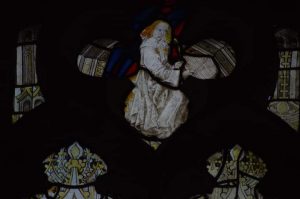
1730s
This is a detail from a majestic painting entitled A Musical Gathering or The Gestingthorpe Choir which shows an early style dulcimer with fixed bridges, in Essex. The painting includes a number of other people who were all amateur musicians from the area near Sudbury in south Suffolk and the dulcimer player is John Elliston, who lived at a house called The Moat in Gestingthorpe, Essex, from 1712 until his death in 1741.
You can now read much more about the owner and the painting here.

1770s
From a couple of decades later (circa 1767/1770) comes an etching known as A Cambridge Concert which depicts a pantaleon, played by professional musician Georg Noelli. Noelli came from Portugal and had studied the pantaleon with its inventor, Pantaleon Hebenstreit in Paris. So neither this instrument nor its player is native to East Anglia, or even England, but there would no doubt have been some interest in the instrument amongst any local people fortunate enough to see it in the Cambridge concert.
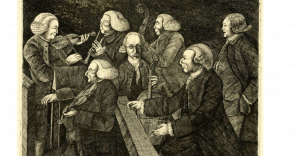
18th century (1)
In his 1976 thesis, David Kettlewell stated that an 18th century instrument in York Castle Museum has a plaque identifying the maker as George Waitball of Walsingham:
“A remarkable instrument, with no soundhole, but painted geometrically-drawn roses in lieu, and a bass extension on the left. The wrest-pins are somewhat uneven, but it seems that there were 14 treble courses, and three groups of bass courses, 7 III, 6 II and 1 I; a single treble bridge remains, so that the instrument was presumably of type 13.2. The label identifies it as the work of George Waitball of Walsingham: an interesting early association with East Anglia.”
Closer inspection of the photograph I have been shown suggests that the maker might actually have been George Marshall and that he may possibly have come from Wolsingham, Co. Durham rather than Walsingham, Norfolk. An exploratory genealogical search brought up a George Marshall (1715-1789) who was born, married and died in Wolsingham, and who was a joiner. I await further information from the York Castle Museum collections team to see if we can clarify matters further.
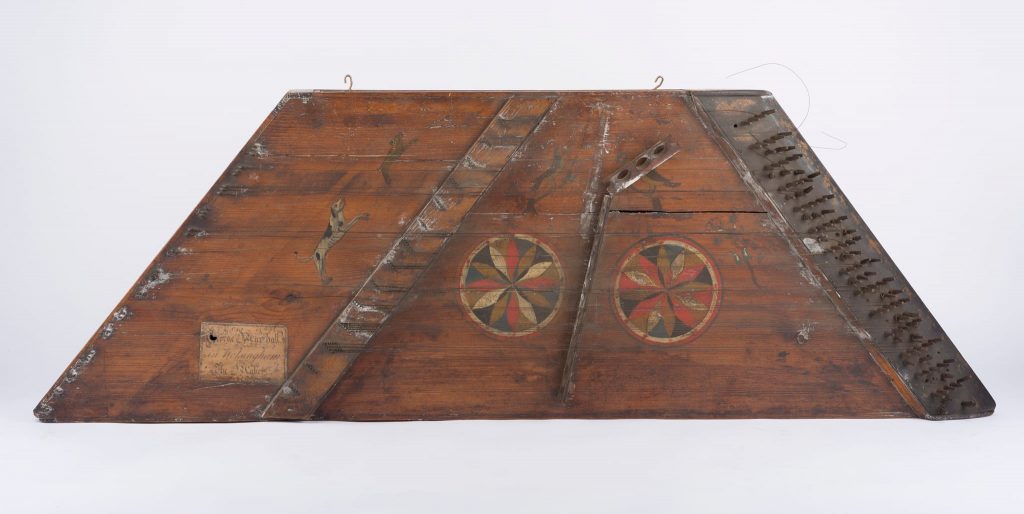
18th century (2)
In 1973, Russell Wortley investigated an instrument described in a then recently published book, ‘Waterways of the Fens’ by Peter Eden (1972). It had been found in Swaffham Bulbeck, Cambridgeshire by Eden, who wrote:

In correspondence with the Wortley, the author Peter Eden said he had sold this dulcimer on to Richard & Joan Arden-Jones of Isleham near Ely but after Wortley went to visit these people in March 1973, he wrote back to Peter Eden that theirs was not the same instrument seen in the illustration, which was of an earlier type and should be considered a museum specimen. Eden did not clarify any further on the provenance or subsequent destination of this fixed-bridge dulcimer. Wortley dated it to circa 1800.
1818
In an article in the Norfolk Chronicle (2 April) mentions a dulcimer being played on the street in Great Yarmouth, Norfolk:
“And now the Fair, like Rubens in his infancy, began to awaken to instrumental music – gun, trumpet, blunderbuss, sackbut, psaltery, and dulcimer; (we beg pardon for any incorrectness in our musical nomenclature, but the excess of noise (we mean melody), seemed to justify every possible enumeration of instruments) …”
1823
In January 1823, the effects of Mr John Blake, manufacturer of bombazine (a textile) were advertised as being for sale at Lovick’s auction rooms, St Andrew’s, Norwich. The items included a barometer, a silver watch and a dulcimer, as well as looms and other weaving equipment, so Mr Blake was evidently a man of some wealth. Whether he had died or gone bankrupt is not clear, and genealogical records have not yet been of any help.
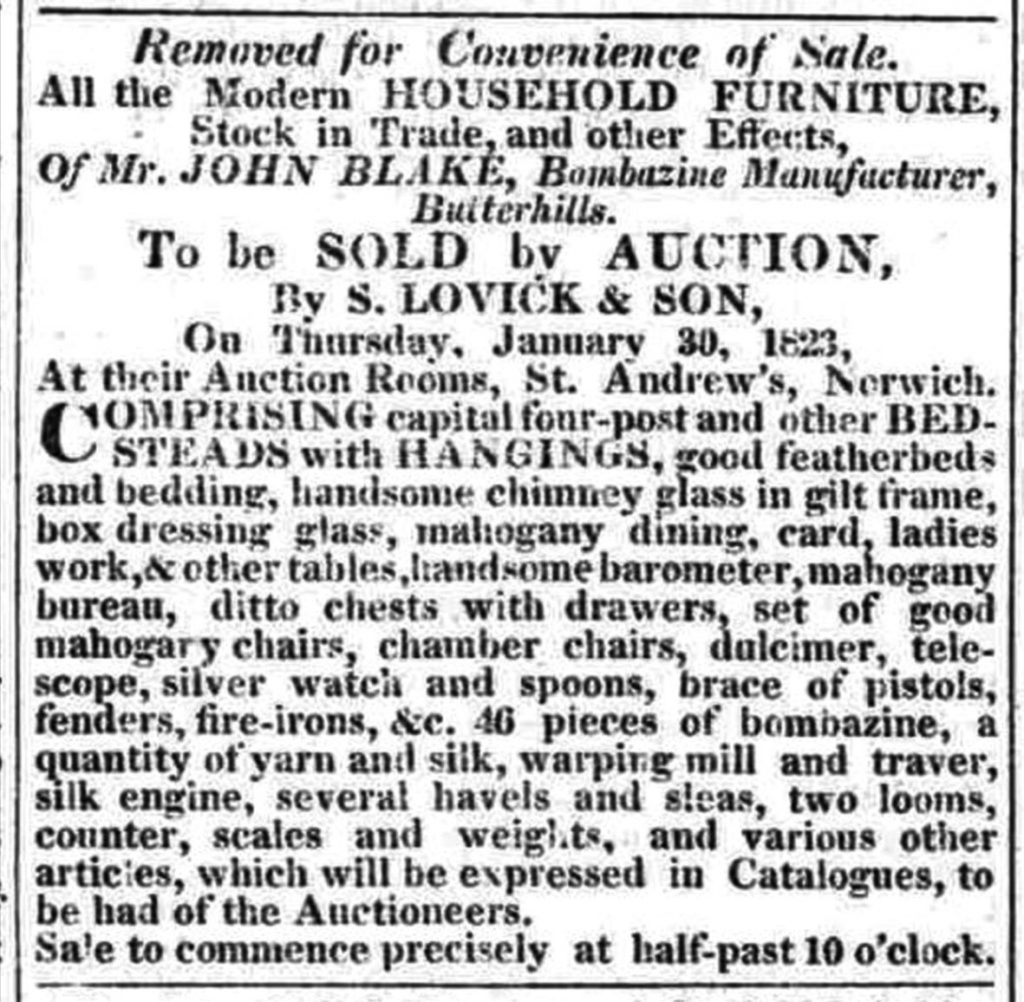
1829
During September 1829, a series of three notices in the Norwich Mercury advertised a forthcoming sale of live and dead farming stock in Kirtley (Kirkley), Lowestoft, the property of the late Thomas Howell. Headlining the items was a “curious spinet, a great piece of antiquity, being nearly 300 years old, a dulcimer, a brass blunderbuss …”
Thomas Howell (1759-1827) was a farmer and had died (“gallstones, worn out”) in 1827 at the age of 68. (Norwich Mercury 26.9.1829).
1833
A dulcimer was advertised in a general sale in Trowse, Norwich.
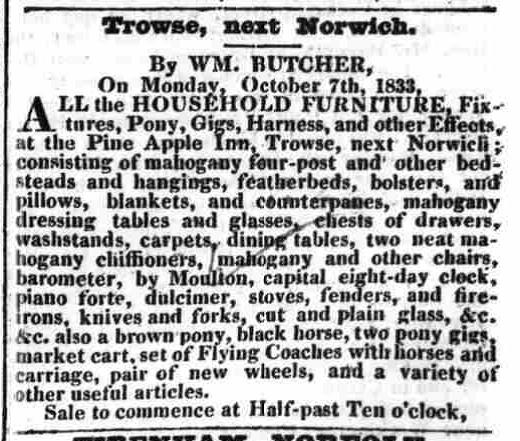
1844
The dulcimer was a popular instrument for travelling musicians, and one such, a Mr. March was much praised in a newspaper report from 1844. His visit to Godmanchester (Huntingdonshire, now Cambridgeshire) had been much appreciated, and he was bound for St Neots next – there is no indication where he came from or what sort of locations/events he and his daughter performed at, but interestingly, “he has a very superior dulcimer” according to the writer! Genealogical investigations have not been able to identify this person.
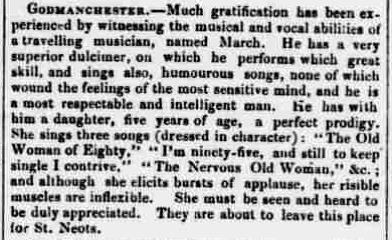
1846
A dulcimer made in Old Weston in 1846 was first mentioned as being in the V&A Museum by David Kettlewell, and subsequently traced to the Horniman Museum. It is a beautiful instrument and at last I have found out who the maker was, John Robinson from Old Weston, Huntingdonshire (now Cambridgeshire).
You can now read all about the maker and the instrument.
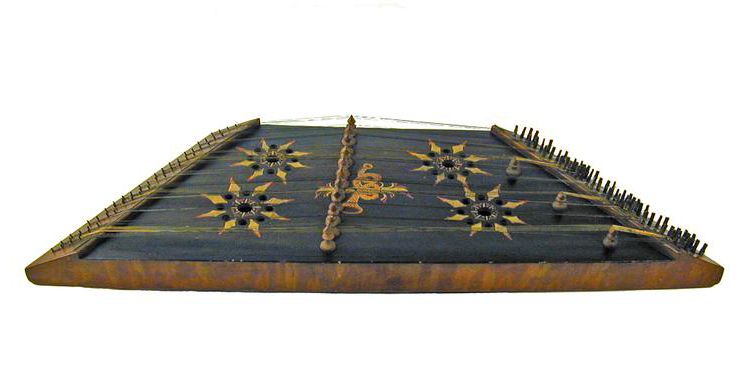
Thanks to Richard Blake for his help regarding the Stratton Strawless stained glass window and the Walsingham/Wolsingham instrument.
All material on this website is copyright. Anyone wishing to quote or use this original research should credit it to Katie Howson and cite this website as the source. Please see our Terms and Conditions page for more information, and do contact me if you wish to use any of the contents in any way. Thank you.
